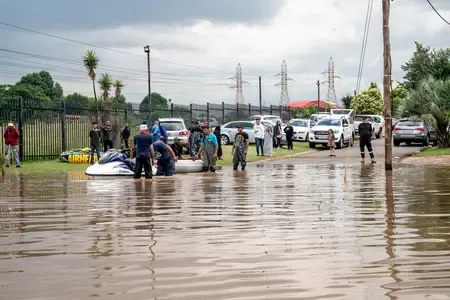Is South Africa Prepared for Severe Weather and Flooding Risks?

Synopsis
Key Takeaways
- South Africa is under multiple severe weather alerts.
- Heavy rainfall of 100 to 150 mm is expected.
- Warnings include potential flooding and infrastructure damage.
- Residents are advised to monitor official updates.
- The storm system will continue into Monday.
Johannesburg, Nov 16 (NationPress) South Africa is currently facing a series of severe weather warnings as a significant cut-off low-pressure system is anticipated to unleash heavy rainfall, thunderstorms, and a heightened risk of flooding across numerous regions, according to the South African Weather Service (SAWS).
The SAWS forecasts that substantial rainfall ranging from 100 to 150 mm, along with intense thunderstorms and strong winds, will occur from Sunday into the early hours of Monday.
An orange level 9 warning has been issued for Gauteng and the western portions of Mpumalanga, cautioning about “disruptive rainfall” that could result in widespread flooding affecting roads and communities, along with life-threatening conditions due to rapidly flowing streams, as reported by Xinhua News Agency.
In Limpopo and various other regions of Mpumalanga, an orange level 6 alert is in effect, warning of severe thunderstorms, strong winds, and heavy precipitation. Additionally, KwaZulu-Natal is under a yellow level 4 warning.
The SAWS has also issued an orange level 5 warning for the North West, Northern Cape, and Free State provinces, which could lead to flooding of low-lying roads and bridges, as well as infrastructure damage.
This storm system is expected to continue through Monday, with potential impacts including flooding of settlements and properties, hazardous driving conditions, infrastructure damage, and disruption of essential services.
The public is urged to stay updated by monitoring the SAWS's official website and social media channels, and to adhere to local authority directives to mitigate risks during this extended weather event.
The SAWS provides impact-based warnings using a color-and-number system to convey both the severity and likelihood of hazardous weather. Yellow indicates a potential minor to moderate impact, orange signals a significant threat, while red denotes severe danger. Each warning is assigned a number from one to ten to illustrate the probability of the event occurring.









